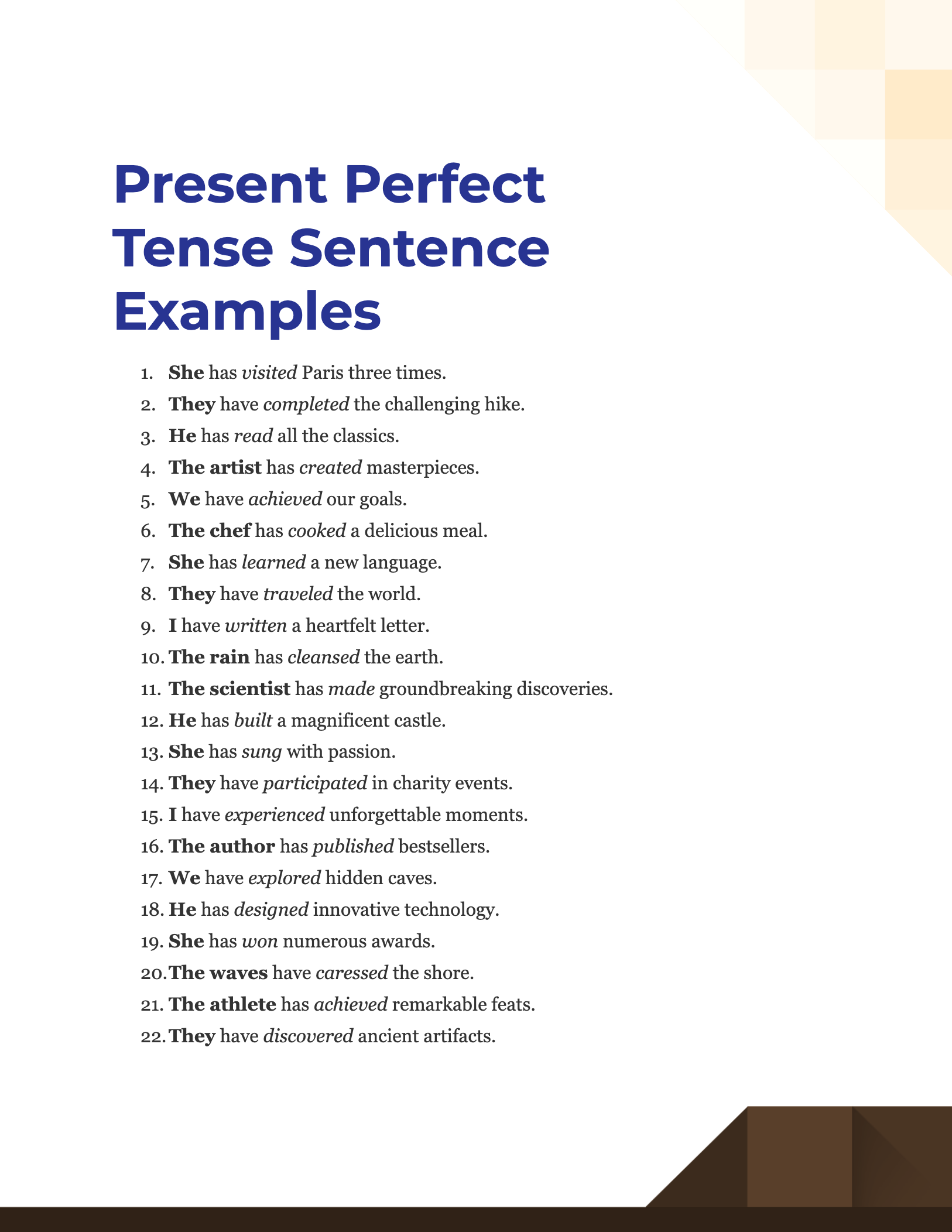99+ Present Perfect Tense Sentence Examples
Step into the world of linguistic precision and time-honored narratives as we explore Present Perfect Tense Sentence Examples, Formula, Exercises, How to Write, and invaluable Tips. In this comprehensive guide, we delve into a grammatical structure that bridges the past and present seamlessly. With clear explanations, engaging examples, and practical exercises, you’ll master the art of constructing sentences that convey actions and experiences with a lasting impact in English. Discover the essence of the Present Perfect Tense and refine your language skills to perfection.
What is the Present Perfect Tense Sentence? – Definition
To embark on this linguistic journey, let’s begin with a concise definition of the Present Perfect Tense. This versatile tense allows us to express actions or events that occurred at an indefinite time in the past but have relevance to the present. In plain and understandable terms, we unravel the essence of this grammatical structure, making it accessible to all.
What is the Best Example of a Present Perfect Tense Sentence?
Now, let’s dive into the heart of the Present Perfect Tense through an exemplary sentence. We’ll provide an in-depth analysis of a sentence that epitomizes the nuances of this tense, illustrating how it’s constructed and how it conveys the sense of connection between past actions and the present moment. With this example, you’ll gain profound insights into crafting your own impactful Present Perfect Tense sentences.
100 Present Perfect Tense Sentence Examples

Embark on a linguistic journey of timeless connections with our collection of 100 unique Present Perfect Tense sentence examples. Each sentence vividly portrays actions or experiences that have relevance to the present moment, with subjects (bold) and verbs (italicized) clearly differentiated. This curated compilation serves as your key to mastering the Present Perfect Tense, offering a diverse range of examples to enhance your command of this essential grammatical structure. Explore the bridge between past and present and elevate your English language proficiency with these captivating sentences.
- She has visited Paris three times.
- They have completed the challenging hike.
- He has read all the classics.
- The artist has created masterpieces.
- We have achieved our goals.
- The chef has cooked a delicious meal.
- She has learned a new language.
- They have traveled the world.
- I have written a heartfelt letter.
- The rain has cleansed the earth.
- The scientist has made groundbreaking discoveries.
- He has built a magnificent castle.
- She has sung with passion.
- They have participated in charity events.
- I have experienced unforgettable moments.
- The author has published bestsellers.
- We have explored hidden caves.
- He has designed innovative technology.
- She has won numerous awards.
- The waves have caressed the shore.
- The athlete has achieved remarkable feats.
- They have discovered ancient artifacts.
- I have captured breathtaking photographs.
- He has invented groundbreaking solutions.
- The applause has echoed in the auditorium.
- The teacher has inspired generations of students.
- She has volunteered for noble causes.
- They have contributed to their community.
- We have celebrated joyous occasions.
- The snowflakes have fallen gently.
- The musician has composed symphonies of beauty.
- He has meditated in tranquility.
- She has conquered her fears.
- They have helped those in need.
- The thunderstorm has rumbled in the distance.
- The doctor has healed countless patients.
- We have forged lifelong friendships.
- He has nurtured a lush garden.
- She has blossomed into a remarkable artist.
- The wind has whispered through the trees.
- The explorer has ventured into the unknown.
- They have discovered hidden treasures.
- I have conducted extensive research.
- He has inspired positive change.
- The river has meandered through the valley.
- The chef has perfected culinary delights.
- She has embraced diverse cultures.
- They have conquered challenging peaks.
- We have forged unbreakable bonds.
- The leaves have rustled in the gentle breeze.
- The architect has designed iconic structures.
- He has sculpted intricate sculptures.
- She has nurtured a vibrant garden.
- They have created innovative art.
- The raindrops have refreshed the earth.
- The teacher has educated generations of students.
- We have celebrated momentous occasions.
- He has constructed sustainable homes.
- She has crafted exquisite jewelry.
- The thunder has echoed through the mountains.
- The doctor has treated patients with care.
- They have organized memorable events.
- I have explored ancient ruins.
- He has inspired innovative solutions.
- The applause has resounded in the theater.
- The mechanic has repaired intricate machinery.
- She has knit cozy blankets.
- They have surfed adventurous waves.
- We have painted vivid canvases.
- The snowflakes have blanketed the landscape.
- The artist has created mesmerizing art.
- He has solved complex equations.
- She has explored distant landscapes.
- They have dedicated their lives to service.
- The river has wandered through the valley.
- The teacher has inspired young minds.
- We have embarked on epic journeys.
- He has designed sustainable cities.
- She has captivated audiences with her talent.
- The wind has whistled through the trees.
- The scientist has discovered new species.
- They have navigated uncharted waters.
- I have photographed breathtaking landscapes.
- He has pioneered groundbreaking technology.
- The thunderstorm has raged in the night.
- The doctor has healed with compassion.
- She has written inspiring literature.
- They have climbed towering mountains.
- We have celebrated life’s milestones.
- The raindrops have nourished the earth.
- The chef has cooked culinary delights.
- He has crafted intricate jewelry.
- She has conquered personal challenges.
- They have volunteered for noble causes.
- The applause has thundered through the stadium.
- The teacher has educated with passion.
- We have traveled to distant lands.
- He has inspired innovation.
- She has captured fleeting moments.
- The river has flowed through the valley.
These 100 unique Present Perfect Tense sentence examples offer a diverse array of scenarios to help you master this essential grammatical structure. Use them to enhance your language skills and craft compelling narratives that seamlessly connect past actions to the present moment.
What is the Formula of Present Perfect Tense Sentence?
Unlocking the structure of Present Perfect Tense sentences is the first step toward mastering this versatile grammatical form. Here’s a comprehensive breakdown of the formula:
Formula: Subject + Have/Has + Verb (past participle) + Object (optional)
- Subject: The doer of the action, typically a noun or pronoun (e.g., “I,” “She,” “They”).
- Have/Has: The auxiliary verb “have” is used with first and second-person subjects (“I,” “You,” “We,” “They”), while “has” is employed with third-person singular subjects (“He,” “She,” “It”).
- Verb (past participle): The main action verb in its past participle form (e.g., “worked,” “studied,” “visited”).
- Object (optional): Represents the receiver of the action (e.g., “a book,” “the museum”).
By following this formula, you can construct Present Perfect Tense sentences that convey actions or experiences that occurred at an unspecified time in the past but are relevant to the present.
What are the Exercises for Present Perfect Tense Sentences?
Effective learning involves practice, and mastering Present Perfect Tense is no exception. Engage in these exercises to sharpen your skills:
Exercise 1: Fill in the Blanks
Complete sentences by filling in the blanks with the correct Present Perfect Tense elements:
- She ________ (travel) to five different countries.
- They ________ (complete) the challenging puzzle.
- He ________ (read) all the books on the shelf.
Exercise 2: Sentence Transformation
Transform simple past tense sentences into Present Perfect Tense sentences:
- Simple Past: “She visited Paris.”
- Present Perfect: “She has visited Paris multiple times.”
Exercise 3: Create Your Own Sentences
Describe your own experiences or actions using the Present Perfect Tense. Share personal stories and anecdotes.
Exercise 4: Time Expressions
Incorporate time expressions like “recently,” “so far,” “already,” and “never” into your sentences to convey different nuances.
Exercise 5: Reported Speech
Practice converting direct speech into reported speech while maintaining the Present Perfect Tense.
Exercise 6: Real-Life Scenarios
Create dialogues and conversations between characters, using the Present Perfect Tense to discuss their past experiences or achievements.
Exercise 7: Narrative Writing
Write short narratives or stories that utilize the Present Perfect Tense to describe characters’ backgrounds or past actions with relevance to the present.
By consistently engaging in these exercises, you’ll not only understand the Present Perfect Tense but also use it fluently in both written and spoken English, enabling you to convey past experiences with clarity and precision.
How to Practice Present Perfect Tense Sentences?
Now that you understand the formula and have practiced, let’s explore how to enhance your skills further:
1. Read Widely:
- Immerse yourself in English literature and articles to observe how native speakers use the Present Perfect Tense in various contexts.
2. Conversational Practice:
- Engage in conversations with native speakers or language partners to practice using the tense naturally.
3. Keep a Journal:
- Maintain a journal where you write about your daily experiences using the Present Perfect Tense.
4. Storytelling:
- Share personal anecdotes and stories with friends, using the tense to describe your experiences.
5. Self-Check:
- Regularly review and self-correct your written and spoken sentences to improve accuracy.
6. Context Matters:
- Understand when to use the Present Perfect Tense versus other past tenses like Simple Past or Past Continuous.
How to Write Present Perfect Tense Sentences? – Step by Step Guide
Creating Present Perfect Tense sentences effectively involves these steps:
1. Select a Subject: Begin by choosing the subject of your sentence, the one who performed the action.
2. Determine the Verb: Identify the main action verb in its past participle form (e.g., “eaten,” “traveled,” “studied”).
3. Use “Have” or “Has”: Employ “have” for first and second-person subjects (“I,” “You,” “We,” “They”), and “has” for third-person singular subjects (“He,” “She,” “It”).
4. Add Time Expressions: Incorporate time expressions like “recently,” “since,” “just,” and “already” to provide context and nuance to your sentences.
5. Proofread and Edit: Always review your sentences to ensure grammatical correctness and coherence.
By following this step-by-step guide, you’ll craft Present Perfect Tense sentences that eloquently convey actions or experiences with relevance to the present, making your writing and speaking more precise and engaging.
Tips for Using Present Perfect Tense Sentences
To maximize your usage of the Present Perfect Tense, consider these valuable tips:
1. Use Time Expressions:
- Incorporate time expressions like “recently,” “so far,” and “just” to specify the timeframe of the action.
2. Distinguish from Simple Past:
- Understand the difference between the Present Perfect Tense and Simple Past Tense to convey the appropriate meaning.
3. Emphasize Relevance:
- Highlight the connection between past actions and the present moment in your sentences.
4. Be Mindful of Irregular Verbs:
- Learn irregular verbs’ past participle forms as they don’t follow standard patterns.
5. Avoid Ambiguity:
- Ensure your sentences are clear and not open to multiple interpretations.
6. Use in Conversations:
- Practice using the Present Perfect Tense in everyday conversations to build fluency.
7. Embrace Variety:
- Combine the tense with other tenses and sentence structures to add diversity to your language use.
8. Proofread and Edit:
- Always review your sentences for accuracy and correctness.
9. Explore Real-Life Scenarios:
- Use the Present Perfect Tense to narrate experiences and accomplishments in real-life situations.
By applying these tips, you’ll effectively use the Present Perfect Tense to express past experiences and actions with precision, enhancing your English language skills and communication abilities.



